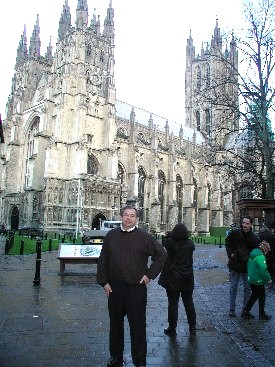A little about Canterbury....
On Tuesday, November 14, 2000 I visited Canterbury with Maurice
Frohn. I had arrived earlier to London in the day from Chicago
for the Annual General Meeting (AGM) of the International Chernobyl
Children's Trust founded by Mr. Frohn of which I am one of the
Trustees. 
Caroline and Maurice Frohn live about 20 miles from Canterbury and he had business there that day. I was able to visit the world famous cathedral and take some of the photos of it and the charming town.
Canterbury is located in the the county of Kent, England. Its cathedral has been the primary ecclesiastical center of England since the early 7th century AD. The city wall was built by the Romans about AD 200 and rebuilt in the Middle Ages; parts of it still stand. Of the six medieval entrances to the city, only Westgate survives.
The site of Canterbury, which has been occupied since pre-Roman times, was formerly the mouth of the River Stour which was at flood stage while we visited.
In the late 6th century Canterbury was the capital of Aethelberht I, king of Kent, whose marriage to a Christian--Bertha, daughter of the Frankish king Charibert--probably influenced him in favor of the mission of St. Augustine of Canterbury, who arrived on the Isle of Thanet in 597 and was given St. Martin's, the queen's parish church. After his consecration at Arles as bishop of the English, Augustine returned to Canterbury, founded the Abbeys of SS. Peter and Paul (known after his death as St. Augustine's Abbey), and established the cathedral, which was originally called Christ Church.

The city suffered severely from bombardment in World War II, though the cathedral was little damaged (fires were lit on the grounds during air raids in order to give the appearance that the cathedral was already in flames).
The cathedral was rebuilt from the 11th to the 12th century and from the 14th to the 16th century, when the present nave and the distinctive tower (Bell Harry tower) were built. A series of capitals in the large crypt is a fine example of Norman architectural sculpture and features animals and monsters of fable. The Corona and the Trinity Chapel have exquisite stained-glass windows, some of which date from the 12th and 13th centuries. The crypt was granted to the Huguenots as their church at the end of the 16th century, and weekly services are still held in French. On the cathedral grounds, Christ Church Gate gives entrance to the remains of the monastic buildings, and a Norman staircase leads to the hall of the King's School, founded in the early Middle Ages as a monastic school and reestablished in 1541 by Henry VIII as a grammar school for boys.
Canterbury today attracts some two million tourists a year. Its many educational institutions include the University of Kent at Canterbury (founded 1965) and Canterbury Christ Church College.